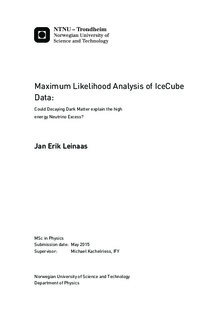Maximum Likelihood Analysis of IceCube Data: - Could Decaying Dark Matter explain the high energy Neutrino Excess?
| dc.contributor.advisor | Kachelriess, Michael | |
| dc.contributor.author | Leinaas, Jan Erik | |
| dc.date.accessioned | 2015-10-06T08:02:41Z | |
| dc.date.available | 2015-10-06T08:02:41Z | |
| dc.date.created | 2015-05-22 | |
| dc.date.issued | 2015 | |
| dc.identifier | ntnudaim:10490 | |
| dc.identifier.uri | http://hdl.handle.net/11250/2352046 | |
| dc.description.abstract | In this theoretical physics master thesis I've looked at a set of observations from a neutrino observatory in Antarctica called IceCube. This observatory has observed more high energy neutrinos than expected. I wanted to investigate whether dark matter would fit as an explanation of this neutrino excess. The visible mass in the universe isn't great enough to explain the dynamics we observe. This has led many to the conclusion that most of the mass in the universe is not visible to us. This masses is called Dark Matter. If Dark Matter decays then neutrinos are one of the possible end products. I have looked at the direction and energy of the neutrino excess at IceCube and investigated statistically how well they fit a model of Dark Matter compared to other models for their origin. The thesis work has been primarily numerical and the program I wrote to answer the main question is found in the appendices at the end. The result was that a small amount of the neutrinos being from Dark Matter decay would fit with observations, but model with no Dark Matter could explain the data almost equally well. | |
| dc.language | eng | |
| dc.publisher | NTNU | |
| dc.subject | Physics (MSPHYS) | |
| dc.title | Maximum Likelihood Analysis of IceCube Data: - Could Decaying Dark Matter explain the high energy Neutrino Excess? | |
| dc.type | Master thesis | |
| dc.source.pagenumber | 99 |
Tilhørende fil(er)
Denne innførselen finnes i følgende samling(er)
-
Institutt for fysikk [2651]

